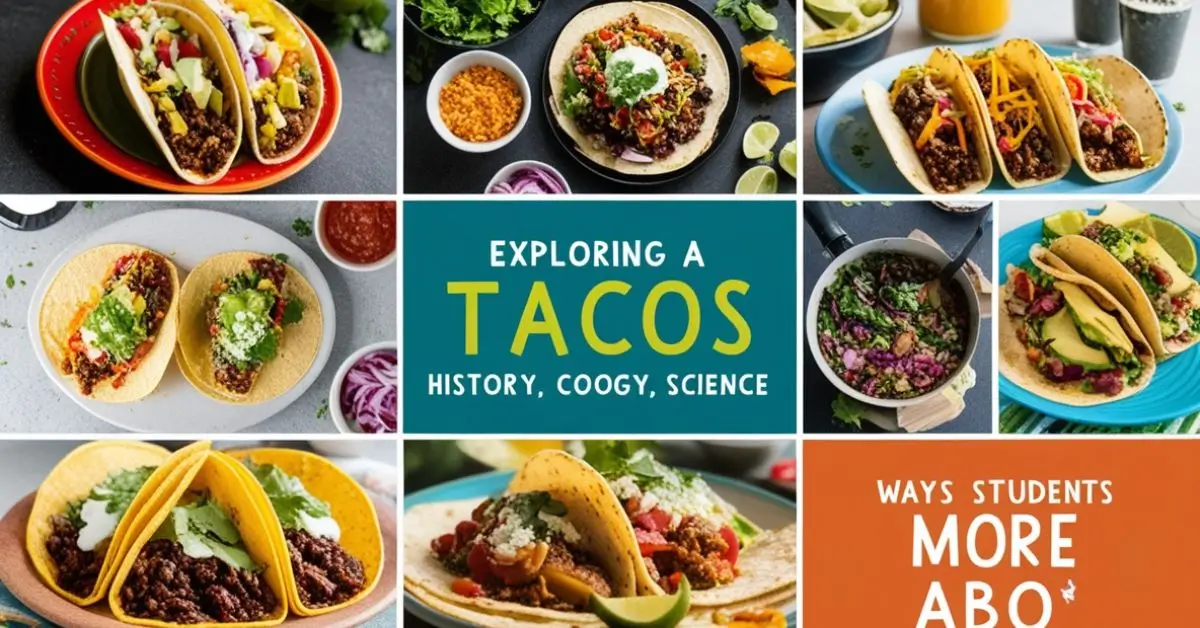How Can We Learn About Tacos for Students? Tacos are more than just a delicious meal—they are a gateway to learning about history, culture, geography, and even science. For students, exploring tacos can be both fun and educational, offering insights into Mexican cuisine, cooking techniques, and the diverse ingredients that make up this beloved dish.
This guide will explore various ways students can learn about tacos, from understanding their history to hands-on cooking and creative projects.
1. The History and Origins of Tacos
Tacos have a fascinating history that dates back centuries. The word “taco” is believed to have originated from silver miners in Mexico, who used small pieces of paper to wrap gunpowder for blasting through rock. Over time, the term was applied to food when tortillas were used to wrap fillings.
Indigenous Mesoamerican civilizations, such as the Aztecs, are known to have eaten food wrapped in corn tortillas long before the Spanish arrived. These early tacos were simple, often filled with small fish, beans, or chili peppers. When Spanish explorers brought livestock such as cows, pigs, and sheep to the region, tacos evolved with new fillings like beef, pork, and cheese.
Through migration and trade, tacos spread beyond Mexico, adapting to local ingredients and preferences in different parts of the world. Today, tacos are a global phenomenon, with countless variations that reflect cultural influences from various regions.
2. Understanding Different Types of Tacos
Not all tacos are the same. Each region of Mexico—and even different parts of the world—has its own unique twist on this dish. Here are some of the most popular types of tacos students can learn about:
| Taco Type | Key Ingredients | Region of Origin |
|---|---|---|
| Taco al Pastor | Marinated pork, pineapple, onions, cilantro | Central Mexico |
| Taco de Barbacoa | Slow-cooked beef or lamb, served with consommé | Northern Mexico |
| Taco de Pescado | Grilled or fried fish, cabbage slaw, lime crema | Baja California |
| Taco de Carnitas | Slow-cooked shredded pork, pickled onions, salsa | Michoacán |
| Taco de Nopal | Grilled cactus, cheese, salsa | Various regions |
Each type of taco reflects local ingredients and cooking methods, making them a great way for students to explore geography and food history.
3. Hands-On Learning: Cooking Tacos
One of the best ways to learn about tacos is by making them from scratch. Cooking teaches students about ingredients, preparation techniques, and even the chemistry behind cooking methods.
Making Homemade Tortillas
Traditional tacos use corn or flour tortillas, which can be made at home with just a few ingredients. Making tortillas allows students to explore the process of nixtamalization—a traditional technique that enhances the nutritional value of corn by soaking it in an alkaline solution.
Experimenting with Fillings
Students can try making different taco fillings to understand how ingredients affect flavor and texture. Some easy-to-make fillings include:
- Vegetarian tacos: Grilled mushrooms, beans, roasted peppers
- Chicken tacos: Shredded chicken cooked with spices
- Beef tacos: Ground beef seasoned with cumin and garlic
- Fish tacos: Battered or grilled fish with lime crema
Cooking also introduces students to nutritional science, teaching them how different foods provide proteins, vitamins, and minerals.
4. Tacos as a Cultural Study
Tacos are more than just food—they represent culture, tradition, and history. Students can explore the cultural significance of tacos by:
- Researching Taco Traditions: Different regions celebrate tacos in unique ways, such as street food vendors in Mexico City or taco trucks in California.
- Understanding Mexican Food Heritage: The way tacos are made and served reflects indigenous and colonial influences.
- Learning About Taco Festivals: Events like National Taco Day and Taco Festivals showcase how tacos bring people together.
By studying tacos, students can gain a deeper appreciation for cultural diversity and food traditions.
5. Using Tacos in the Classroom
Teachers can incorporate tacos into lessons across multiple subjects:
History & Social Studies
- Study how tacos evolved from ancient Mesoamerican cuisine to modern fast food.
- Explore how Mexican migration influenced food culture worldwide.
Geography
- Map out where different taco variations originate.
- Learn about the agricultural products used in tacos, such as corn, avocados, and chilies.
Science
- Discover the chemistry behind marinating meats.
- Learn about the nutritional benefits of taco ingredients.
Mathematics
- Practice measurements by scaling taco recipes.
- Use fractions when dividing ingredients for multiple servings.
Language Arts
- Write essays about the history of tacos.
- Create a descriptive food review of a taco experience.
By integrating tacos into different subjects, students engage in learning in a fun and interactive way.
6. Watching Taco-Themed Videos & Documentaries
Visual learning can enhance a student’s understanding of tacos. There are many online videos that showcase the history of tacos, cooking techniques, and cultural significance. Some examples include:
- How to Make Authentic Tacos – Step-by-step cooking guides for different taco styles.
- The History of Tacos – Educational videos about how tacos originated and spread worldwide.
- Street Food Documentaries – Films exploring Mexico’s famous taco vendors.
Watching these videos helps students connect with the subject visually, making learning more engaging.
7. Attending Taco Festivals and Events
Experiencing tacos in real life is an excellent way for students to learn. Many cities host taco festivals where people can taste different types of tacos, watch live cooking demonstrations, and learn from expert chefs.
Visiting local Mexican restaurants or taco trucks is another great way to observe taco-making in action and speak with people who are passionate about the dish.
8. Creative Taco Projects for Students
Encouraging students to take on projects about tacos can be both fun and educational. Here are some ideas:
- Create a Taco Recipe Book: Collect traditional and modern taco recipes.
- Document a Taco Tasting Experience: Visit different taco places and compare flavors.
- Make a Taco Presentation: Research a specific taco style and share findings with classmates.
- Design a Taco Poster: Illustrate the components of a perfect taco with descriptions.
These creative approaches allow students to express their learning in different ways while developing research and presentation skills.
Conclusion: Tacos as an Educational Journey
Tacos are more than just food—they offer a rich learning experience that touches on history, culture, science, and geography. Whether through cooking, research, multimedia, or hands-on projects, students can gain valuable insights into the world of tacos.
By exploring tacos in fun and engaging ways, students not only learn about Mexican cuisine but also develop a deeper appreciation for the traditions and cultures behind this iconic dish.












